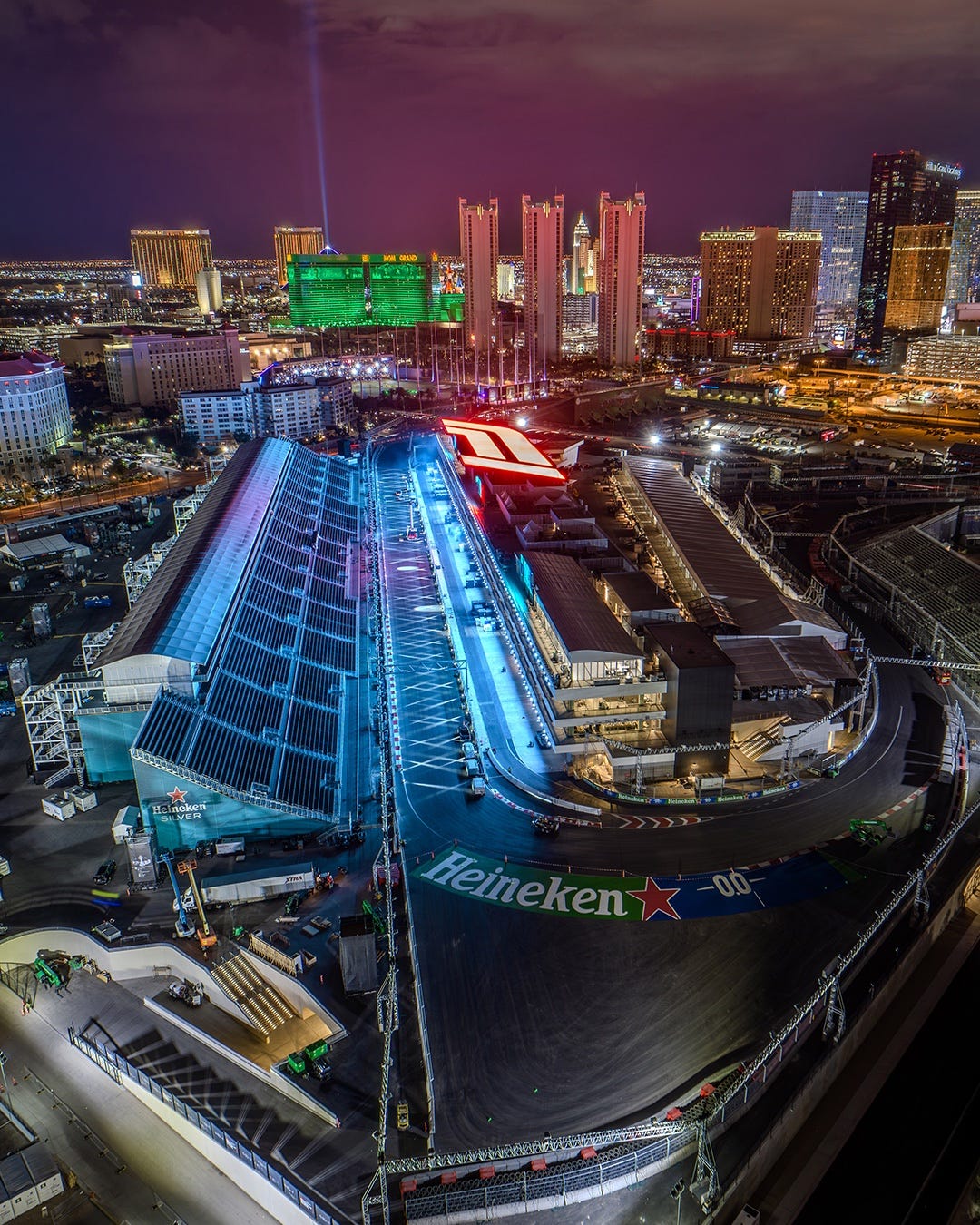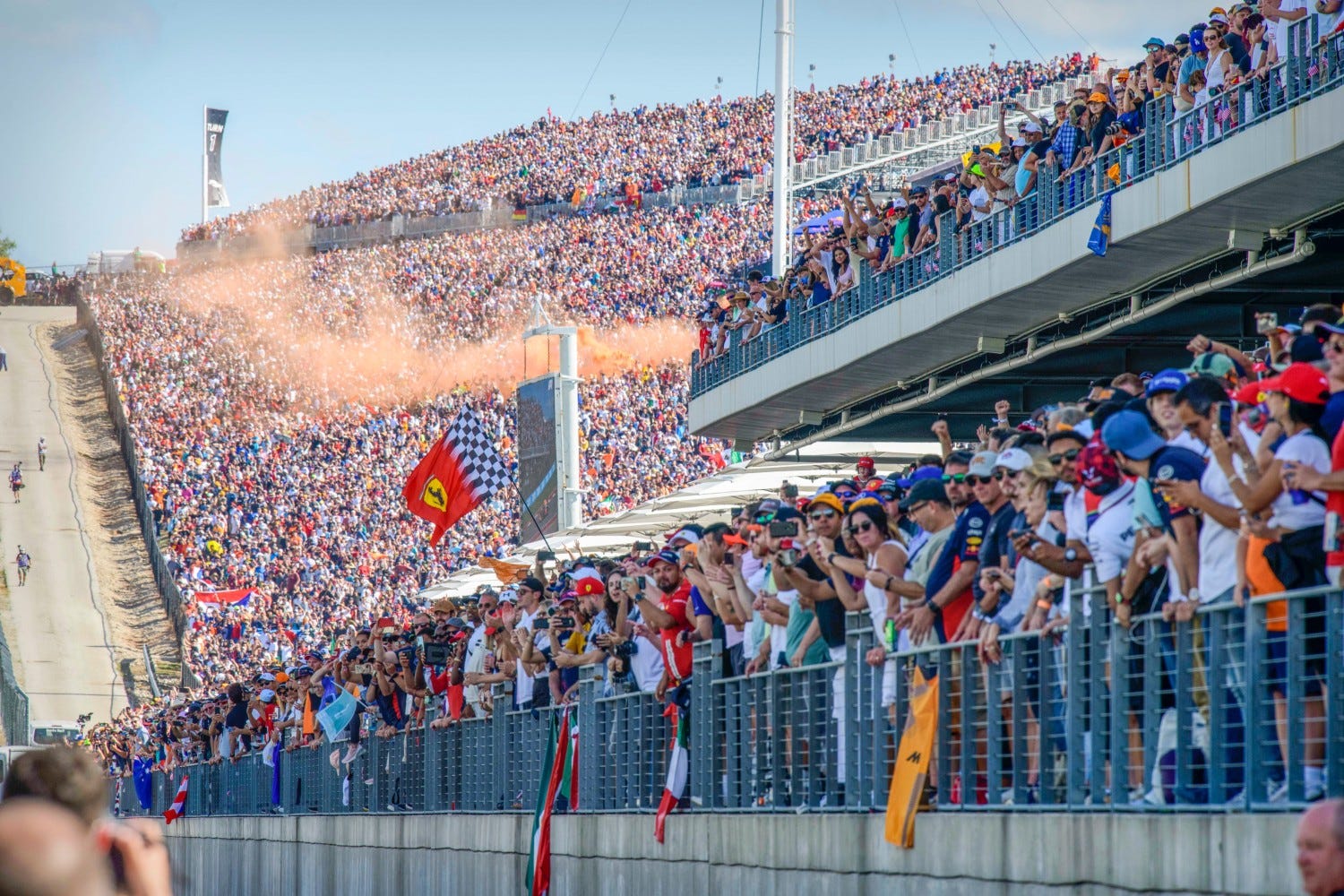Formula 1 Isn’t Leaving Las Vegas Anytime Soon
Huddle Up is a 3x weekly newsletter that breaks down the business and money behind sports. If you are not already a subscriber, sign up and join 100,000+ others who receive it directly in their inbox each week. Friends, The leadup to Formula 1’s Las Vegas Grand Prix could be classified as a disaster. Thousands of locals (and tourists) have complained about intensive road work, road closures, traffic, and long commutes. Hotel prices on the Las Vegas strip have dropped roughly 80% since the race was announced last year, and race tickets are also down more than 40%, as over 10,000 tickets remain unsold just days before the race. Furthermore, construction workers have been working 90-hour weeks leading up to the event to ensure everything gets done on time. This will also be one of the coldest Formula 1 races on record, as F1 officials have publicly said they didn’t consider the temperature when planning the race. And US viewership isn’t going to break any records, either, as qualifying and the race starts at 3 AM and 1 AM Eastern Time, respectively, meaning roughly 50% of the country will be asleep during the race. Add in the fact that the 3.8-mile, 17-turn racetrack doesn’t offer the drivers a real challenge, and many are already claiming this race won’t be back in Vegas next year. But I don’t think that’s true — and it all comes down to one thing: MONEY. Ps. This newsletter is also available via podcast on Apple or Spotify. When Liberty Media (also owners of MLB’s Atlanta Braves) acquired Formula 1 for $4.4 billion in 2016, they saw a unique opportunity to grow the sport internationally. Take the NFL, for instance. The NFL has fewer viewers than the English Premier League (EPL). However, they still bring in about $20 billion in annual revenue, which is more than the world’s top 5 soccer leagues (Premier League, Bundesliga, Serie A, La Liga, and Ligue 1) combined. This is because the United States is the world’s most lucrative economy, and they monetize sports assets better than anyone. This context is essential because Formula 1 had historically struggled with US expansion — they literally gave ESPN the US TV rights for free in 2017 — but it also represented an immense opportunity for Liberty Media to increase enterprise value. And that’s precisely what they have done. Liberty Media loosened social media rules, allowing teams and drivers access to official race footage. They launched an over-the-top (OTT) streaming service called F1TV, providing fans with a one-stop-shop for all Formula 1-related content. They also turned race weekends into music festival-style events, with concerts, food, and more. And most importantly, they launched F1: Drive to Survive with Netflix, a series that every sports league globally is now trying to copy. The results of these moves from Liberty Media and Formula 1 can’t be understated. Formula 1 now reaches over 1 billion spectators annually, and 77% of these fans are under the age of 35. Formula 1 is also the fastest-growing major sports property across Facebook, Twitter, Instagram, YouTube, TikTok, Snapchat, Twitch, and Chinese social media platforms, with total followers now up to more than 65 million. And here’s the craziest stat: the average age of a Formula 1 fan has dropped from 36 years old in 2017 to 32 years old today. That’s better than MLB (57), NFL (50), NHL (49), and NBA (42), and it proves Liberty Media’s digital-first approach is working. Most importantly, this had an outsized impact on F1’s presence in the United States. Formula 1 now has three races in the United States: Miami, Austin, and Las Vegas. That is more races than any other country on the calendar, and these races continue to set records, like 440,000 people showing up to the USGP in Austin, Texas, in 2022. But the inaugural Las Vegas Grand Prix offers Liberty Media a unique opportunity. You see, Formula 1 is traditionally an asset-light business. They don’t own the teams, the cars, or even the racetracks. Instead, countries worldwide pay Formula 1 between $20 million to $55 million annually to host races. These countries then serve as race promoters, selling tickets, sponsorships, and expensive hospitality packages. This has historically been a great business model for F1 — you limit your downside by simply collecting $50M+ hosting fees and signing lucrative broadcasting agreements. But while it has been lucrative over the years, it also limits F1’s financial upside. This is why, for the first time ever, Liberty Media and Formula 1 decided to serve as the promoters for their own race in Las Vegas. And it’s also why the Las Vegas GP won’t be leaving the calendar anytime soon: because F1 won’t let it leave the calendar. Think about it this way: Liberty Media has already invested over $500 million of its own money on this race, including buying a 39-acre piece of land for $240 million last year to build a permanent, four-story, 300,000-square-foot paddock building. Furthermore, even with 10,000 tickets still unsold, Liberty Media and F1 are going to make a killing on this event. The cheapest ticket on race day ($1,000+) is still more expensive than any of the other 20+ races on the calendar, and several people have told me that Miami’s ownership group makes more money off ticket sales for the Miami Grand Prix (3 day-event) than they do all of NFL season (8-9 home games each year). That’s just the tip of the iceberg, too. There will be events, parties, and concerts all week long. Netflix hosted its first-ever live sports event — The Netflix Cup — at the Wynn on Tuesday, and the most popular hotels have a 95%+ occupancy rate, equating to millions in revenue. Also, another thing to remember is that cities spend billions of dollars in taxpayer money to build new NFL stadiums based on the hope that they will eventually be awarded a Super Bowl. But this year’s Las Vegas Grand Prix is projected to bring a $1.7 billion economic impact to Las Vegas, which is roughly 2-3x more than what the city expects for this year’s Super Bowl. That economic impact is also why the Clark County Commission (aka Las Vegas) has already agreed to extend Formula 1’s use of the Las Vegas Strip through 2032. So don’t expect Formula 1 to be leaving Las Vegas anytime soon. Their new 300,000-square-foot permanent paddock will serve as the company’s home base in the United States. It will be open to tourists throughout the remaining months of the year, and for all its faults leading up to the event, the Las Vegas GP should look great on TV. If you enjoyed this breakdown, please consider sharing it with your friends. I hope everyone has a great day. We’ll talk on Friday. Listen to the Joe Pomp Show on Apple or Spotify. Join my sports business community on Microsoft Teams. Interested in advertising with Huddle Up? Email me. Your feedback helps me improve Huddle Up. How did you like today’s post? Loved | Great | Good | Meh | Bad Huddle Up is a 3x weekly newsletter that breaks down the business and money behind sports. If you are not already a subscriber, sign up and join 100,000+ others who receive it directly in their inbox each week. Huddle Up is free today. But if you enjoyed this post, you can tell Huddle Up that their writing is valuable by pledging a future subscription. You won’t be charged unless they enable payments.
© 2023 |


